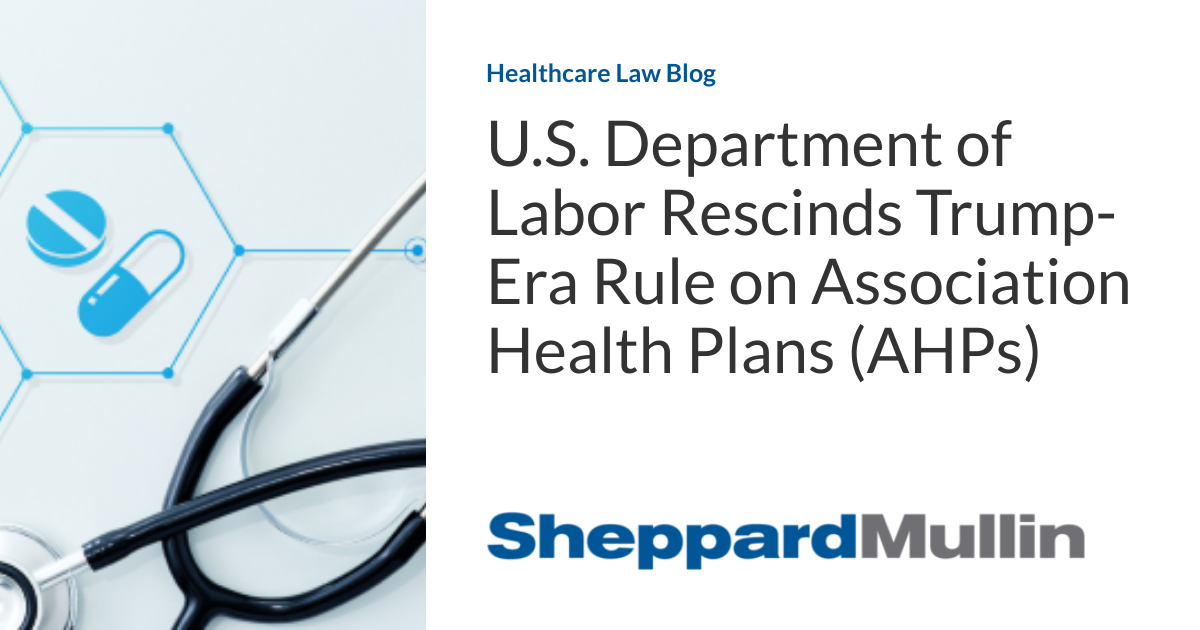On April 29, 2024, the U.S. Department of Labor (the “DOL”) issued a remaining rule (the “Final Rule”) rescinding the 2018 Association Health Plan rule (“2018 AHP Rule”), thereby marking a return to the extra inflexible pre-2018 regulatory framework governing affiliation well being plans. The 2018 AHP Rule, formally titled “Definition of Employer Under Section 3(5) of ERISA – Association Health Plans,” allowed these plans to bypass sure necessities below the Affordable Care Act (“ACA”). The Final Rule will take impact on July 1, 2024.
The DOL’s determination to rescind the 2018 AHP Rule follows authorized challenges, considerations about market stability, and the DOL’s need to align the rule with the Biden Administration’s aim of enhancing entry to high quality well being protection. According to the DOL, the 2018 AHP Rule was a major departure from the DOL’s longstanding pre-rule steerage on the definition of “employer” below ERISA and considerably weakened the DOL’s conventional standards in a fashion that may have enabled the creation of business AHPs functioning successfully as medical insurance issuers. The 2018 AHP Rule set forth different standards below ERISA for figuring out when employers and associations could be a part of collectively to sponsor a single group well being plan below ERISA.[i] For instance, the 2018 AHP Rule required that the group or affiliation have “at the very least one substantial enterprise goal unrelated to providing and offering well being protection or different worker advantages to its employer members and their staff.”[ii] Previous steerage required that such group or affiliation “should exist for functions apart from offering well being advantages.”[iii] The intent behind the 2018 AHP Rule was to encourage the creation of AHPs as options for inexpensive well being protection for small employers and self-employed people.
A 2019 determination by the U.S. District Court for the District of Columbia largely invalidated the 2018 AHP Rule, discovering that parts of the rule have been unreasonable interpretations of ERISA designed to avoid the necessities of ERISA and the ACA.[iv] Further, in line with the DOL’s Final Rule Fact Sheet, the 2018 AHP Rule “struck the fallacious steadiness between guaranteeing a ample employment connection and enabling the creation of AHPs.” The DOL thought of, however finally determined towards, proposing a rescission of simply these provisions vacated by the federal district court docket, concluding that the provisions held invalid by the district court docket have been so central to the rule that eradicating them would undermine the core goals of the 2018 AHP Rule.
This recission reinstates the DOL’s pre-rule steerage and longstanding standards for AHPs, which emphasised the necessity for an employment nexus through which AHPs have been sometimes required to have a commonality of curiosity amongst members based mostly on their employment. The pre-2018 AHP Rule steerage applies a facts-and-circumstances method for figuring out whether or not a gaggle or affiliation is a bona fide employer succesful of sponsoring an ERISA plan for its members by using the next three standards:
- Whether the group or affiliation has enterprise or organizational functions and capabilities unrelated to the supply of advantages (the “enterprise goal” normal);
- Whether the employers share a commonality of curiosity and real organizational relationship unrelated to the supply of advantages (the “commonality” normal); and
- Whether the employers that take part in a profit program, both instantly or not directly, train management over this system, each in type and substance (the “management” normal).[v]
When making use of the three standards above to a gaggle or affiliation, the DOL additionally considers the next elements:
- how members are solicited;
- Who is entitled to take part and who truly participates within the group or affiliation;
- the method by which the group or affiliation was shaped;
- the needs for which it was shaped;
- what, if any, have been the preexisting relationships of its members;
- the powers, rights, and privileges of employer members that exist by purpose of their standing as employers;
- who truly controls and directs the actions and operations of the profit program; and
- the extent of any employment-based commonality or different real organizational relationship unrelated to the supply of advantages.[vi]
According to the Fact Sheet, the DOL is unaware of any teams or associations relying on the 2018 AHP Rule, and as such, doesn’t count on the choice to end in any regulatory prices or burdens.
FOOTNOTES
[i] 29 CFR 2510 (June 21, 2018)
[ii] 29 CFR 2510 (June 21, 2018)
[iii] 29 CFR 2510 (April 30, 2024)
[iv] New York v. U.S. Department of Labor, 363 F. Supp. 3d 109 (D.D.C. 2019).
[v] 29 CFR 2510 (April 30, 2024)
[vi] 29 CFR 2510 (April 30, 2024)

